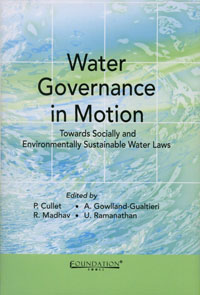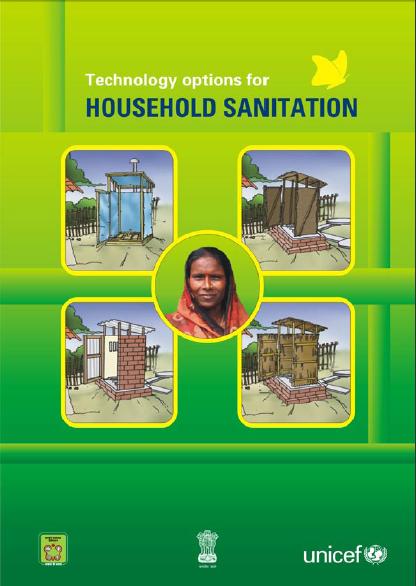Wastewater Reuse and Recycling
Water governance in motion: Towards socially and environmentally sustainable water laws
Posted on 18 Nov, 2010 10:48 AM

Water Governance in Motion: Towards Socially and Environmentally Sustainable Water Laws focuses on the work undertaken by International Environmental Law Research Centre IELRC on water law reforms in India. It seeks to provide a broader understanding of the conceptual framework informing existing water law and ongoing reforms.
Evaluation of sanitation and wastewater treatment technologies: Case studies from India
Posted on 15 Nov, 2010 11:52 PMThe sanitation systems studied are spread across the country. The study goes to Pratapnagar in Bihar to evaluate the success of the septic tank to Asalthpur in Uttar Pradesh to study the Ecosan (UDDT) toilet. Other locations in India include Maharashtra, Gujarat, Kerala.
Technology options for household sanitation - A report by the Ministry of Rural Development and UNICEF
Posted on 15 Nov, 2010 10:14 PM As part of the Total Sanitation Campaign (TSC), the Ministry of Rural Development under the Rajiv Gandhi National Drinking Water Mission and UNICEF have brought out a compedium that details the various sanitation technologies available to above and below poverty line households .
As part of the Total Sanitation Campaign (TSC), the Ministry of Rural Development under the Rajiv Gandhi National Drinking Water Mission and UNICEF have brought out a compedium that details the various sanitation technologies available to above and below poverty line households .
The authors have divided the report into three subjects - the first being the need for household sanitation and the extent of the problem in rural India. The second section looks at sanitation technology in general with a focus on rural areas and technologies for different conditions. The third part deals with operation and maintenance of such technologies and includes a chapter on components of a toilet.
Status of water supply, sanitation and solid waste management in urban areas – A research study by CPHEEO (2005)
Posted on 11 Nov, 2010 10:16 PMThis study by the Central Public Health and Environmental Engineering Organisation (CPHEEO) assesses the status of water supply, sanitation and solid waste management in selected 300 cities and towns of India including all metropolitan cities and selected Class I and Class II urban centres. It estimates the requirement of funds for full coverage of population by these services in the urban areas of the country from 1999 to 2022 (at five yearly intervals). Overall, the study confirms the normal notion that the metropolitan cities are better provided for than the other size class of urban centres.
The Orissa water supply and sewerage board act - Government of Orissa (1991)
Posted on 12 Oct, 2010 03:16 PMThis document describes the details of the Orissa Water Supply and Sewerage Board Act, 1991 and includes:
- The short title, extent and the commencement of the Act
- The definitions of the terms used in the Act
- The details regarding the establishment of the Orissa Water Supply and Sewerage Board, conduct of business duties and powers of the board
- The details of vesting of property, assets, liabilities and obligations and transfer of property to the board
- Contract, finance, account and audits of the board
- Fees and charges decided by the board
- Definition of supply of water for domestic purposes under the Act
- Right of the owner or occupier to obtain sewer connection
- Penalties and proceedures
- External control
Multi stage aerobic bio reactor for sewage treatment
Posted on 01 Oct, 2010 10:13 PMAbout CAT “MAR” (Multi Stage Aerobic Bio Reactor)
This reactor was developed with the aim to overcome the main problem associated with SBR, MBR & FABBR, i.e.,
- The plugging & clogging of filter and
- Wash out microbes from the reactor
Manual on water supply and treatment - CPHEEO (MoUD)
Posted on 15 Sep, 2010 11:17 PMThis manual has been developed by the Central Public Health and Environmental Engineering Organisation (CPHEEO), a department under the Ministry of Urban Development (MoUD) and serves as a standard guide in public health engineering by providing a code of day to day practice for public health engineers to follow.
Allocation of water charges for multi-housing communities in India: Sub-metering and ratio utility billing system (RUBS)
Posted on 10 Sep, 2010 01:35 PMOne of the most serious issues of water management is the question how to allocate the water resources to guarantee sufficient amount of water for all demands. That is why, it can be expected that allocation management will gain further importance in the future. It is not exaggerated to declare that “the issue of allocation overshadows all other aspects of water management”.
Engineers training on Decentralised Wastewater Treatment Systems (DEWATS), CDD, Bangalore
Posted on 06 Sep, 2010 01:19 PM
Organizer: Consortium for DEWATS Dissemination (CDD) Society
Venue: Centre for Advanced Sanitation Solutions (CASS), Bangalore
Description:
The Consortium for DEWATS Dissemination (CDD) Society is a not-for-profit organisation working in the field of decentralised basic need services across India. Decentralised solutions for waste water treatment, water and energy supply, solid waste management and urban sanitation planning are successfully promoted for the past ten years.
Assessing and improving water productivity in conservation agriculture systems in the Indus-Gangetic basin – A working paper by Challenge Program on Water and Food
Posted on 22 Aug, 2010 02:38 PMThe paper by Challenge Programme on Water and Food (CPWF) attempts to assess and improve water productivity in conservation agriculture systems in the Indus-Gangetic basin, in which during the past 40 years an intricate mosaic of interactions between man & nature, poverty & prosperity and problems & possibilities has emerged. Rapid expansion in agricultural water use is a common theme across these interactions and access to water is central to the livelihoods of the rural poor.




